|

|
German History in Images and Artefacts from Two Millenia
|
| |
|
In this exhibit more than 8,000 historical objects testify to political events and struggles as
well as to social, economic and intellectual developments. Spread across two floors of the
former Prussian armory building, with illustrative multi-media stations and special
pedagogical opportunities, it presents an enthralling and intellectually enriching tour of the
vicissitudes of German history in its greater European context from the beginning of our
common era into the present that the visitor can customize according to their personal
interest.
second floor: 1 BCE – 1918 |
ground floor: 1918 – Present |
|
|
|
| 1 BCE – 1500 CE
| |
|
Early cultures and the Middle Ages
  The advance of the Romans up to the Rhine and the Donau in the century before Christ put
an end to the political and cultural self-sufficiency of the Celts and Germanic peoples in mid-Europe. Archeological finds show us that the coexistence of Romans and Germanic tribes
was shaped not only by military conflicts such as the Battle of the Teutoburg Forest in 9 CE,
but also increasingly by vigorous trade contacts. The Roman civilization, language and
alphabet remained following the downfall of the Roman state after the 5th century and bound
together later Europe.
With the coronation of Charlemagne as emperor in the year 800, the empire of the Romans
was transferred to the Franks. Charlemagne expanded his Frankish kingdom to the most
powerful in all of Europe, unified law and administration, and set educational reforms in
motion. Under the emperors emerged the “Holy Roman Empire of the German Nation”, a
feudal association of numerous lands and regional authorities lasting into the 15th century.
Material records of everyday life and the works of medieval art give us insight into the
significance of religion and of the imperial church as well as into the hierarchically classbased
society of the Middle Ages.
The advance of the Romans up to the Rhine and the Donau in the century before Christ put
an end to the political and cultural self-sufficiency of the Celts and Germanic peoples in mid-Europe. Archeological finds show us that the coexistence of Romans and Germanic tribes
was shaped not only by military conflicts such as the Battle of the Teutoburg Forest in 9 CE,
but also increasingly by vigorous trade contacts. The Roman civilization, language and
alphabet remained following the downfall of the Roman state after the 5th century and bound
together later Europe.
With the coronation of Charlemagne as emperor in the year 800, the empire of the Romans
was transferred to the Franks. Charlemagne expanded his Frankish kingdom to the most
powerful in all of Europe, unified law and administration, and set educational reforms in
motion. Under the emperors emerged the “Holy Roman Empire of the German Nation”, a
feudal association of numerous lands and regional authorities lasting into the 15th century.
Material records of everyday life and the works of medieval art give us insight into the
significance of religion and of the imperial church as well as into the hierarchically classbased
society of the Middle Ages.
|
| 1500 – 1650
| |
|
Reformation and the Thirty Years’ War
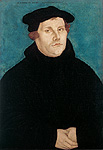 In the 16th century the teachings of Luther, whose distribution was aided by mechanical
book-printing, were the impulse for a reform of the church that resulted in profound religious
and political changes in the Empire. The three distinct confessions emerged. Political power
was split into followers and opponents of the Reformation. The Religious Peace of Augsburg
in 1555 brought decades of peace and encouraged the growth of urban culture in many
places. Around 1600 confessional differences and political conflicts were aggravated and led
to the Thirty Years’ War from 1618-1648. The Empire was the theater of this war, to whose
dreadful events we have testimony not only in drawings and reports of the time but in the
armor and weapons from the historical armory collection. Other European powers entered into the battles,
in which the religious occasion became a background concern to the
interests of power politics. Not until 1648 could the Peace of Westphalia create a new
European order, which, however, was to guarantee peace for the next half-century.
In the 16th century the teachings of Luther, whose distribution was aided by mechanical
book-printing, were the impulse for a reform of the church that resulted in profound religious
and political changes in the Empire. The three distinct confessions emerged. Political power
was split into followers and opponents of the Reformation. The Religious Peace of Augsburg
in 1555 brought decades of peace and encouraged the growth of urban culture in many
places. Around 1600 confessional differences and political conflicts were aggravated and led
to the Thirty Years’ War from 1618-1648. The Empire was the theater of this war, to whose
dreadful events we have testimony not only in drawings and reports of the time but in the
armor and weapons from the historical armory collection. Other European powers entered into the battles,
in which the religious occasion became a background concern to the
interests of power politics. Not until 1648 could the Peace of Westphalia create a new
European order, which, however, was to guarantee peace for the next half-century.
|
| 1650 – 1789
| |
|
Supremacy and German dualism in Europe
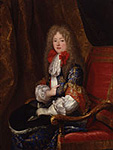 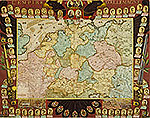 Following the end of the Thirty Years’ War, several dynasties vied for predominance in
Europe, with the French kings and the Austrian Habsburgs in the lead. Louis XIV of France
became the epitome of the absolute monarch and his court set the standard for courtly
ceremony and for the aristocratic culture preserved in numerous buildings and luxury goods.
Among the German lords a limited sovereignty emerged, marked by an adulterated form of
absolutism.
When the Emperor Charles VI died without an heir in 1740, the political struggle between
Austria and Prussia escalated. Besides Prussia, Bavaria and France also objected to the
Habsburg Maria Theresa succeeding to the imperial throne. This unleashed the War of the
Austrian Succession, from which five great European powers emerged and now struggled for
their various interests to prevail: England and France fought over their overseas territories,
Austria and Prussia fought a war from 1756-1763 over Silesia. Following this Seven Years’
War the expansionist drive of Austria, Prussia and Russia was directed against Poland.
Following the end of the Thirty Years’ War, several dynasties vied for predominance in
Europe, with the French kings and the Austrian Habsburgs in the lead. Louis XIV of France
became the epitome of the absolute monarch and his court set the standard for courtly
ceremony and for the aristocratic culture preserved in numerous buildings and luxury goods.
Among the German lords a limited sovereignty emerged, marked by an adulterated form of
absolutism.
When the Emperor Charles VI died without an heir in 1740, the political struggle between
Austria and Prussia escalated. Besides Prussia, Bavaria and France also objected to the
Habsburg Maria Theresa succeeding to the imperial throne. This unleashed the War of the
Austrian Succession, from which five great European powers emerged and now struggled for
their various interests to prevail: England and France fought over their overseas territories,
Austria and Prussia fought a war from 1756-1763 over Silesia. Following this Seven Years’
War the expansionist drive of Austria, Prussia and Russia was directed against Poland.
|
| 1789 – 1871
| |
|
From the French Revolution to the second German Empire
 The repercussions of the French Revolution spread rapidly throughout Europe and led to
wars in the course of which the Holy Roman Empire collapsed in 1806. Under Napoleon,
France’s power extended far into mid-Europe by 1812. In Prussia and the new states of the
Rhine Confederation political and social reforms were carried out. After the Napoleonic Wars
against the French emperor, the political and territorial changes in Germany could no longer
be undone. The Congress of Vienna of 1814/15 re-established the old monarchies and
brought a stabile and peaceful order. In the states of the German Confederation the first
industrial centers could arise and traffic and trade routes were built up.
The massive repression of liberal-democratic and nationalist movements led to the
revolutions of 1848/49, as a result of which the first German National Assembly was
convened in Frankfurt and worked out a constitution. Yet in Germany the attempt to establish
a democratic state of constitutional law was unsuccessful. In 1871, after three wars against
Austria, Denmark and France under Prussian hegemony, the German Empire was founded
as a nation-state.
The repercussions of the French Revolution spread rapidly throughout Europe and led to
wars in the course of which the Holy Roman Empire collapsed in 1806. Under Napoleon,
France’s power extended far into mid-Europe by 1812. In Prussia and the new states of the
Rhine Confederation political and social reforms were carried out. After the Napoleonic Wars
against the French emperor, the political and territorial changes in Germany could no longer
be undone. The Congress of Vienna of 1814/15 re-established the old monarchies and
brought a stabile and peaceful order. In the states of the German Confederation the first
industrial centers could arise and traffic and trade routes were built up.
The massive repression of liberal-democratic and nationalist movements led to the
revolutions of 1848/49, as a result of which the first German National Assembly was
convened in Frankfurt and worked out a constitution. Yet in Germany the attempt to establish
a democratic state of constitutional law was unsuccessful. In 1871, after three wars against
Austria, Denmark and France under Prussian hegemony, the German Empire was founded
as a nation-state.
|
| 1871 – 1918
| |
|
The German Empire and the First World War
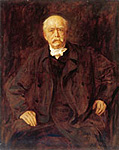 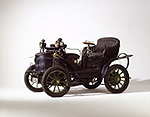 The German Empire arose in 1871 as a federation of states under a constitutional monarchy.
The Prussian king Wilhelm I, as German emperor, became the head of the state. In his
function as chancellor, Bismarck tried to secure the Empire’s position through a policy of
European alliances. Domestically his aim was to stabilize the new empire with an
authoritarian government and in securing societal equilibrium. In 1888 Wilhelm II became
emperor. Initially he supported social and political reforms, but rejected the idea of
democratizing the Empire. Around the turn of the century an economic upsurge enabled
entrepreneurs and those of the educated middle class to rise to a new elite, but it also
concealed great conflicts in domestic politics. Attempts to incorporate the working class and
social democracy into the state failed due to the resistance of agrarian, industrial and middleclass
interests. Nationalism, the economic drive for expansion and social unrest produced a
climate in which the peace was increasingly felt to be a limitation.
In 1914 the oppositions within power politics in Europe along with the arms race led to the
First World War. Hopes for a rapid victory were demolished in the barrages of trench warfare.
In 1918 Germany surrendered and Wilhelm II had to abdicate the throne. The war unleashed
new republican forces in Germany and in other parts of Europe.
The German Empire arose in 1871 as a federation of states under a constitutional monarchy.
The Prussian king Wilhelm I, as German emperor, became the head of the state. In his
function as chancellor, Bismarck tried to secure the Empire’s position through a policy of
European alliances. Domestically his aim was to stabilize the new empire with an
authoritarian government and in securing societal equilibrium. In 1888 Wilhelm II became
emperor. Initially he supported social and political reforms, but rejected the idea of
democratizing the Empire. Around the turn of the century an economic upsurge enabled
entrepreneurs and those of the educated middle class to rise to a new elite, but it also
concealed great conflicts in domestic politics. Attempts to incorporate the working class and
social democracy into the state failed due to the resistance of agrarian, industrial and middleclass
interests. Nationalism, the economic drive for expansion and social unrest produced a
climate in which the peace was increasingly felt to be a limitation.
In 1914 the oppositions within power politics in Europe along with the arms race led to the
First World War. Hopes for a rapid victory were demolished in the barrages of trench warfare.
In 1918 Germany surrendered and Wilhelm II had to abdicate the throne. The war unleashed
new republican forces in Germany and in other parts of Europe.
|
| 1918 – 1933
| |
|
Weimar Republic
 From out of the revolutionary shocks of the First World War, the German empire emerged in
1918 as a parliamentary democracy. The occupation of the Ruhr Valley, the inflation and the
grievous economic crisis threatened the coherence of the young Weimar Republic. In the
tattered landscape of the political parties, contrary visions of the political form of Germany
stood opposed to one another. Left-wing and right-wing extremists fought the democratic
order. During a brief phase of relative stability, the economy recovered and avant-garde
forms of art and culture came into bloom. The frequently alternating government coalitions
failed to find effective means to fight social destitution and unemployment. In the world
depression, the situation worsened. The political radicalization of the population made
possible the rise of the NSDAP to a party of the masses with the strongest faction in
parliament.
From out of the revolutionary shocks of the First World War, the German empire emerged in
1918 as a parliamentary democracy. The occupation of the Ruhr Valley, the inflation and the
grievous economic crisis threatened the coherence of the young Weimar Republic. In the
tattered landscape of the political parties, contrary visions of the political form of Germany
stood opposed to one another. Left-wing and right-wing extremists fought the democratic
order. During a brief phase of relative stability, the economy recovered and avant-garde
forms of art and culture came into bloom. The frequently alternating government coalitions
failed to find effective means to fight social destitution and unemployment. In the world
depression, the situation worsened. The political radicalization of the population made
possible the rise of the NSDAP to a party of the masses with the strongest faction in
parliament.
|
| 1933 – 1945
| |
|
NS regime and the Second World War
 After Hitler was named chancellor in 1933, the National Socialists rapidly established a
dictatorship that was to prepare Germany for war through a radical reformation of state and
society. The NS state brutally persecuted its political opponents. Jews and others that didn’t
fit the racist ideals of National Socialism were ostracized from society.
With the German attack on Poland in 1939 began the Second World War. By 1941 the
German army occupied Denmark, Norway, the Benelux countries, France, Greece,
Yugoslavia and parts of northern Africa. In the attack on the Soviet Union in 1941, special
task forces followed in the wake of the army and murdered hundreds of thousands of Jews,
Sinti and Romany as well as Soviet functionaries. As of 1942 the NS state deployed all
means to organize the genocide of the European Jews in concentration camps and
implement it by the millions. A war coalition led by the Soviet Union, Great Britain and the USA opposed itself to the
German offensive war. After landing on Normandy in 1944, the Allied troops drove back the
German army on all fronts and advanced towards Germany. The Red Army began the attack
on Berlin in April, 1945. Germany’s unconditional surrender on the 8th of May, 1945 ended
the NS reign and the Second World War in Europe, which had claimed over 50 million
human lives.
After Hitler was named chancellor in 1933, the National Socialists rapidly established a
dictatorship that was to prepare Germany for war through a radical reformation of state and
society. The NS state brutally persecuted its political opponents. Jews and others that didn’t
fit the racist ideals of National Socialism were ostracized from society.
With the German attack on Poland in 1939 began the Second World War. By 1941 the
German army occupied Denmark, Norway, the Benelux countries, France, Greece,
Yugoslavia and parts of northern Africa. In the attack on the Soviet Union in 1941, special
task forces followed in the wake of the army and murdered hundreds of thousands of Jews,
Sinti and Romany as well as Soviet functionaries. As of 1942 the NS state deployed all
means to organize the genocide of the European Jews in concentration camps and
implement it by the millions. A war coalition led by the Soviet Union, Great Britain and the USA opposed itself to the
German offensive war. After landing on Normandy in 1944, the Allied troops drove back the
German army on all fronts and advanced towards Germany. The Red Army began the attack
on Berlin in April, 1945. Germany’s unconditional surrender on the 8th of May, 1945 ended
the NS reign and the Second World War in Europe, which had claimed over 50 million
human lives.
|
| 1945 – 1949
| |
|
Germany under Allied occupation
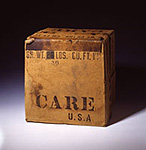 After the capitulation the Allies divided the country, devastated in large areas, into four
occupied zones. The regions east of the Oder and the Neisse were subject to Polish or
Soviet administration. More than 12 million refugees and exiled streamed out of the East into
the zones administrated by the victorious powers. The daily struggle for survival taxed the energy and
pushed any coming to terms with the Nazi regime and its crimes into the
background. Initially the Germans only had very limited possibilities of shaping their political
future. A common policy towards Germany among the Allied powers collapsed with the
emergence of the “Cold War“. The Soviet Union pressed ahead with the restructuring of their
zone according to Soviet-Socialist notions, whereas the Western Allies tried to integrate their
occupied zones into the confederation of Western democracies.
After the capitulation the Allies divided the country, devastated in large areas, into four
occupied zones. The regions east of the Oder and the Neisse were subject to Polish or
Soviet administration. More than 12 million refugees and exiled streamed out of the East into
the zones administrated by the victorious powers. The daily struggle for survival taxed the energy and
pushed any coming to terms with the Nazi regime and its crimes into the
background. Initially the Germans only had very limited possibilities of shaping their political
future. A common policy towards Germany among the Allied powers collapsed with the
emergence of the “Cold War“. The Soviet Union pressed ahead with the restructuring of their
zone according to Soviet-Socialist notions, whereas the Western Allies tried to integrate their
occupied zones into the confederation of Western democracies.
|
| 1949 – 1994
| |
|
Divided Germany and Re-unification
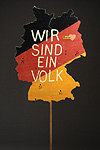 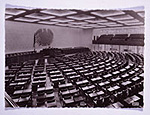 As of 1949 there existed two German states. The German Democratic Republic established
a Socialist one-party regime according to the Soviet model. West Germany arose under the
influence of the Western Allies as a democratic, federalist state. The border between the two
states consisted at first of barbed wire, and as of 1961 of the wall built by the GDR. The
“Cold War” of the super-powers determined foreign policy. In the 1970s, however, a process
of détente began, carried forward by the world powers. West Germany remained committed
to democratic principles despite economic crises and domestic policy conflicts, whereas by
the end of the 80s high state debts, an inflexible planned economy and rigid power structures
accelerated the downfall of the GDR regime. The opening of the Berlin Wall sealed the end
of the GDR state and paved the way for its accession to West Germany on October 3, 1990,
with the consent of the Allies in the Two Plus Four Agreement. Berlin became the capital and
seat of government.
As of 1949 there existed two German states. The German Democratic Republic established
a Socialist one-party regime according to the Soviet model. West Germany arose under the
influence of the Western Allies as a democratic, federalist state. The border between the two
states consisted at first of barbed wire, and as of 1961 of the wall built by the GDR. The
“Cold War” of the super-powers determined foreign policy. In the 1970s, however, a process
of détente began, carried forward by the world powers. West Germany remained committed
to democratic principles despite economic crises and domestic policy conflicts, whereas by
the end of the 80s high state debts, an inflexible planned economy and rigid power structures
accelerated the downfall of the GDR regime. The opening of the Berlin Wall sealed the end
of the GDR state and paved the way for its accession to West Germany on October 3, 1990,
with the consent of the Allies in the Two Plus Four Agreement. Berlin became the capital and
seat of government.
|
|
|
|
